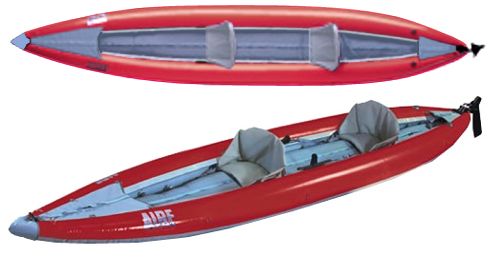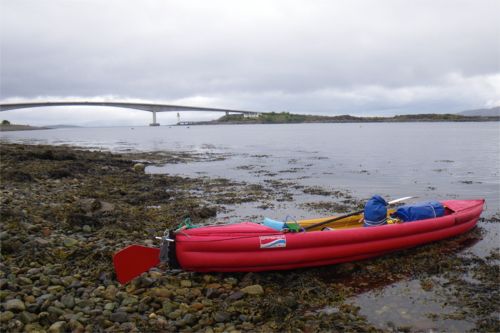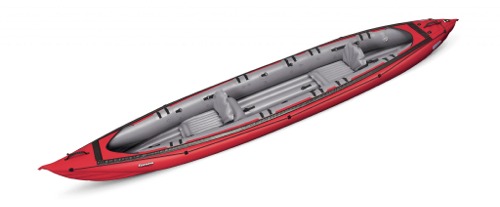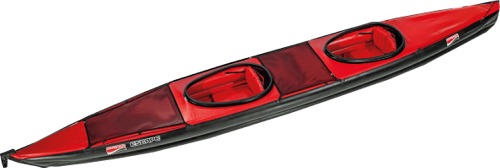Gumotex "Sunny" (hand-made in Europe, Nitrilon fabric, something like £500 new) on Loch na Keal, Scotland. He caught a lot of mackerel.
 |
Gumotex "Sunny" (hand-made in Europe, Nitrilon fabric, something like £500 new) on Loch na Keal, Scotland. He caught a lot of mackerel.
You can carry an inflatable kayak in a medium-size rucksack. Serious inflatable kayaks cost roughly £500 to £1250. If you're used to traditional kayaks, they're a bit slow, but they can be very tough and long-lasting, and they have done some remarkable trips.
WARNING: Far too many inflatable kayaks are just swimming pool toys. If you forget that, if you take them out to sea, they may kill you. They're made in tens of thousands on Chinese production lines that have no environmental protection, no job security, very little quality control and no knowledge of kayaking on cold seas. Amazon sells them. People sell them at street markets. Price is no guide - some supermarkets have sold 'pool toy' kayaks for less than £50, but some of them are offered as 'adventure equipment' for more than £500. That's a colossal profit margin for a cheap, nasty product. It's also a way to suggest that these flimsy, dangerous toys are strong, durable and safe. So how do you tell the difference? Mainly by going to an expert website with product reviews (A Paddle in my Pack - see below). The main thing to watch for is that the shell of a nasty inflatable kayak is probably made of the same quality of fabric that is used for poolside chairs, and the parts that inflate are probably made of unreinforced PVC (vinyl) that's no stronger or more durable than a kids' paddling pool. The seams are probably RF-welded. Unreinforced PVC fabric and cheap valves cannot hold the high pressures that make a serious IK into a relatively stiff boat; unreinforced PVC is thin and easily punctured. It will become brittle with age as the plasticisers evaporate, and it can just split open where you had it folded up over winter. An entire seam can suddenly pop open because the RF welding fails, dumping you in the water in less than a second. A nasty inflatable kayak probably has a life of less than 3 years of summer use. They're designed as badly as they're made, so they're very slow, hard to paddle in a straight line and impossible to control in windy conditions.
OK, enough about the nasty end of the market!
A serious inflatable kayak or IK has a lot in common with folding kayaks and it's made by hand, from the same incredibly tough fabrics. A serious IK is wonderful if you want to travel by air with your kayak; or if you want to take kayaks on your yacht; or if you live in a city apartment and you find that a rigid kayak (a 'hardshell') won't go up the stairs or into the lift.
If you buy a serious IK and not a PVC pool toy, you're getting the same quality and technology as in inflatable dinghies, yacht tenders, professional lifeboats and even military assault craft. You certainly don't have to worry about your precious kayak falling 2 metres onto concrete, or even 10 metres - it'll bounce. Also, serious IKs are no more affected by sliding over sharp rocks than the typical hardshell kayak. As with inflatable dinghies, there are inflatable kayaks that are still good after 40 or 50 years of summer use.
Of course, neither folding kayaks nor IKs are the perfect solution for everybody's kayaking needs. Any kayak can get a hole in it. With a hardshell kayak, this is unlikely to be more than a nuisance; you paddle to the nearest beach and fix it, or your friends raft up for a few minutes so you can fix it at sea. If you get a puncture in an inflatable, even though it probably has at least two separate buoyancy chambers, your kayak may not be much of a kayak any more; how far are you from a beach or other point where you can get ashore? How cold's that water? And you may need workshop conditions to do a repair.
Good inflatable kayaks are fairly expensive. That's because good fabrics are expensive and assembling them takes a lot of skilled work, using two-part adhesives in a controlled environment. IKs are generally shorter and fatter than a rigid kayak, so they're slower and they have a shorter range. Most of the volume inside an IK is used for the air that keeps them inflated, so they don't have much space for equipment. A hardshell sea kayak of a classic design can operate in quite strong winds; an experienced hardshell kayaker can enjoy paddling in Force 4 winds, maybe Force 5. Even Force 6 can be quite fun for short periods if you're both strong and expert. With an inflatable kayak, there will be a lot more days when it's too windy to go paddling.
Editor's note: For the rest of this page, I'm going to hand you over to somebody who's not just an expert kayaker, but an expert in the use of inflatable kayaks - Chris S of A Paddle In My Pack: Inflatable Kayaks & Packrafts. Visit his site at http://apaddleinmypack.wordpress.com
Thanks, Chris, over to you (last updated November 2020):
An inflatable kayak (IK) has the same benefits of portability as a folding kayak but is usually lighter and quicker to assemble - typically 10 minutes. The stigma of IKs as being soggy beach toys is beginning to ease as some manufacturers produce inflatable kayaks suited to coastal exploration. They include Aire (USA), Advanced Elements (USA), Grabner (Austria), Gumotex (Czech Republic, branded Innova in North America), Incept (New Zealand) and Sea Eagle (USA). Links at Kayarchy Shopping - Sea Kayaks - Inflatable.
Quality IKs are made from the same tough rubber- or plastic-coated fabrics as folders, and are built in three ways:
Method 1: The hull is an outer cover with zipped or open-ended sleeves to take removable and repairable air bladders (like tyre inner tubes). Examples include Aire’s 4.6-metre, 18.6-kilo budget Sawtooth or the shorter Super Lynx. (Editor's note: Despite my rude comments about cheap, nasty kayaks and unreinforced PVC air bladders, this can be a legitimate way to build a serious IK - as long as you know what you're doing!)
Method 2: Sections of the hull are glued or heat-welded to form a sealed ‘tubeless’ vessel of at least three chambers: a wide, flat floor; and two side tubes. Examples include Gumotexís Seawave (4.5m and 17kg), Incept’s solo Tasman (4.3m; 17kg) and Pacific double, or Grabner’s Holiday and Escape series of IKs, with doubles up to 5m long.
Method 3: Dropstitch (DS) fabric technology is the big new thing in IKs. The boat is made of two or more usually, three flat panels (floor and two sides), rather like a simple wooden boat. Each panel consists of two outer surfaces that are joined to each other internally by thousands of stitches of space yarn. This makes them into a slightly curved, semi-rigid panel once inflated. A dropstitch panel can hold up to five times more pressure than a tubed IK which can result in hardshell-like stiffness, even if hull forms remain comparatively unsophisticated. Currently, all these full dropstitch IKs are made in China from Korean Selytech fabric, then spun off under various brands around the world who specify their own custom features. They include: Sea Eagle Razorlite (USA) and in Europe: DS Kajak/Kxone, Bic Yakkair HP, Allroundmarin and Decathlonís slim, solo decked X500.
Some IKs only have a drop stitch floor with regular round tube sides, like some Sea Eagles, Advanced Elements, Gumotex Rush 2 and Aquaglides. Because of layer upon layer of PVC, the weight of full DS IKs is usually a little greater than traditional tubed IKs, while speed, efficiency, and above all, interior space are improved.
The basic Aire models are undecked, self-bailing boats – you’ll get wet but the boat won’t swamp. The Incepts include a zip-back deck with a coaming hatch to take a spray skirt, as do some Aire and Advanced Elements designs, while Grabner and Gumotex offer strap-on spray covers for some of their boats.
It worth noting that all the finely engineered handling and stability characteristics of a hardshell sea kayak do not apply to IKs, whether they're DS or otherwise: a few are tippy; most are as stable as a raft. The Aires are self-bailing IKs: youíll get wet but the boat wonít swamp. However because self-bailing needs thick floors to keep you out of the swill, which means a higher centre of gravity for the crew, these boats have speed-killing widths to maintain stability.
The Incepts include a zip-back deck with a coaming hatch to take a spray skirt, as do some Advanced Elements, while Grabner and Gumotex offer boats with fixed decks (Escape; Framura) or attachable covers for other models.
Once a non-dropstitch IK gets over about four metres long, longitudinal hull flex can become an issue with a heavy paddler aboard. Grabner, Gumotex's Seawave and Incept get round this with relatively high pressures of up to 0.3 bar (4.5psi) and Incept and Grabner use twin side beams instead of one big side tube to further resist folding in the swell and keep the boat slim. This helps limit swamping but can also increase windage. As mentioned, the new DS IKs get around this by being as rigid as boards; the question is: how does a flat boat handle at sea? Rudders and thigh braces are additional ways of improving control and paddling efficiency, and downwind sails are easily adapted to inflatables too.
As for speeds, the fastest sea-going IKs are probably the Incepts, Gumotex Seawave and Framuras as well as the slimmer-than-most full DS models like Sea Eagleís Razorlite and DS Kajakís Airtrek FLex. All these should cruise at nearly 5 miles per hour in calm conditions.
Punctures and slow leaks are actually much less of a problem than most imagine, although when the sharks are circling or swordfish breaching, being in an inflatable kayak can give you pause. An IKís biggest drawback at sea is its susceptibility to high winds. Because itís relatively light, buoyant and has a lot more hull above the water than a hardshell or folding sea kayak, it can get hard to handle in winds above Force 4. And when the sea gets rough a conventional IK wonít cut through the chop like a cheese-cutting hardshell, while flat-bottomed hulls will rolled around in side waves. Strong quartering winds will also cause an IK to weathercock, which even a rear load and a rudder canít always overcome. All IKs come with (and at sea, need) a removable skeg. Some come with or have optional rudder kits.
And so, more than with other sea kayaks, you need to carefully evaluate weather conditions with an IK. That requires experience and good judgement, or simply caution. Over a couple of seasons experienced French kayaker Gaël Auffret succeeded in paddling the 500-kilometre Scottish Sea Kayak Trail alone in a 12-year old Grabner Holiday 2.
Capsizing is less of an issue and might be regarded as an IKís safety feature, particularly for paddlers who donít get on with the hemmed-in feeling of a decked hardshell. Although something like an Incept or Framura can be rolled, itís often easier to simply bail out and flip the boat back upright, if necessary. An undecked IK will shed most of its water as you do this. You then crawl back aboard, all in less than a minute; no balletic finesse, paddle floats or bilge pumping required. The main risk of falling out is having your light and buoyant IK blow away quicker than you can swim after it. Over many decades the late IK legend Audrey Sutherland (her books are listed here) paddled 12,000 miles, often alone, in British Columbia, Alaska and Hawaii in a kayak on which the current Incept design is based. In rough conditions she made sure she was tethered to her boat.
Realistically, using an IK for long sea expeditions like Audrey or Gaël is an eccentric choice. Properly handled, a hardshell is simply more efficient. But for the less ambitious fair-weather coast-hopping that most sea paddlers engage in, the best IKs make safe, stable platforms for inshore exploration, and with a bit of creative packing can be transported anywhere in the world within regular baggage-allowance limits.
Thank you, Chris! To find out more about inflatable kayaks and packrafts, visit Chris's site at : http://apaddleinmypack.wordpress.com
• Aire Sea Tiger. No longer made, but see Aire's 2020 Sawtooth model. I met one of the old Sea Tigers on the west coast of Scotland, being used as a tender to a sailing trimaran. When powered by two strong kayakers, it was a nice, fast boat even in the strong winds and currents of the Hebrides.

• Grabner Holiday 2. Gaël Auffret's photo of his inflatable kayak (usually seen in warmer seas!) by the Skye Bridge in Scotland:

Chris particularly mentions the Gumotex Seawave (for which a waterproof deck is available so the two paddlers can wear spraydecks and stay warmer and drier) ...

... the Grabner Escape 2, again available with a deck so you can wear a spraydeck...

...and the Sea Eagle Razorlite:

| Go to next page for: • Sea kayak design • Why a long, narrow kayak? • Kayak stability • Radical designs |